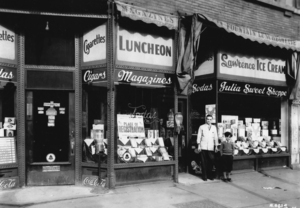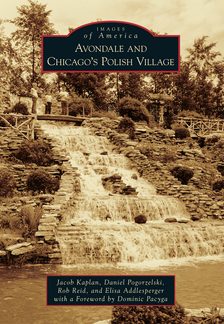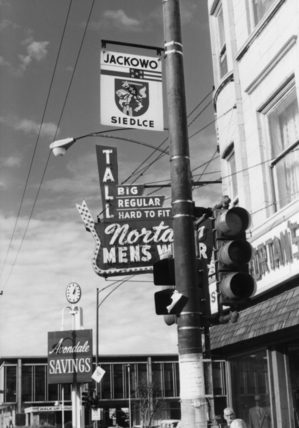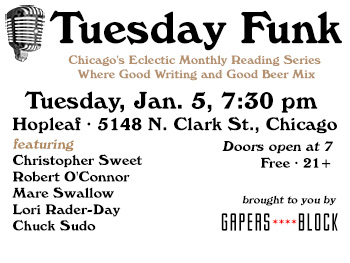| « Holy 75th Birthday, Batman! | Near Ye, Near Ye! Your Weekend in Words » |
Books Thu Jul 24 2014
Avondale and Chicago's Polish Village Celebrated in Book Release this Weekend
Join others to say, "Na zdrowie!" this Sunday July 27th, 6pm, in celebration for the book release of Images of America Avondale and Chicago's Polish Village (on Arcadia Publishing) at the Podlasie Club, 2918 N. Central Park. The book catalogs the neighborhood's rich cultural history, supported by over a hundred photographs (see below) and a foreword from notable Chicago biographer Dominic Pacyga. The book was co-authored by Jacob Kaplan, Dan Pogorzelski, Rob Reid and Elisa Addlesperger.
I connected with one of the authors, Dan "Pogo" Pogorzelski, to discuss this book and how the writers encapsulated the cultural relevance of this neighborhood. Pogo holds authority when telling the story of the Polish Village, the neighborhood where he was born. His professional career has allowed him to stay active in the community. He can be seen at neighborhood farmer's markers as a community outreach assistant for a state Senator, online as a writer for Forgotten Chicago, and as a preservationist with his appointment as Vice President of the Northwest Chicago Historical Society. He is no stranger to authoring books about beloved Chicago neighborhoods as he was involved two books in Arcadia's Images of America series documenting Bridgeport and Portage Park (which was co-authored by John Maloof, director of Finding Vivian Maier).
To begin, what was the initial motivation to write this book, one centered on Avondale and Chicago's Polish Village?
"The neighborhood that built Chicago" has a charm that intrigued all four of us co-authors. In my case, I was born in this neighborhood, and I still remember my father helping collect donations for POMOST, a local anti-communist organization, outside of St. Hyacinth Basilica every week after mass. This aspect of the history of Avondale and Chicago's Polish Village is just one facet of what makes this area interesting. While the heart of Polish Chicago certainly has beat strong in this neighborhood during Poland's struggles for independence, other ethnic voices have always been a vital part of its evolution and development, just like in every other hallowed ethnic enclave in our city. Industry, Labor, the Progressive Movement, the Interstate Highway System have all left a visible mark here. The person whom we chose to dedicate our book to, a longtime community activist by the name of Joe Jurek, had political guru David Axelrod run his campaign for public office well before Axelrod sprang to fame (thanks to electing Barack Obama as President). Our aim was to weave all of these intriguing strands into one narrative, one that intersects with notable figures such as Street Photographer Vivian Maier, First Lady Hillary Clinton, Pope John Paul II, the elites of Polish Rock music, as well as Wayne Campbell and Garth Algar from the film Wayne's World.
 There were multiple authors of the book, so how did you all work to create a seamless story about the neighborhood's history?
There were multiple authors of the book, so how did you all work to create a seamless story about the neighborhood's history?
I would say this was a great experience, as we were all seasoned professionals in regards to writing, and it truly was a team effort. Thanks to the diversity of our experiences, we were each able to make sure that the unique perspective we had on this area was included.
How long did it take for this project, from the beginning stages through the book's publication?
In a certain sense, I think this was a project each one of us four co-authors had been preparing for quite a while. The actual process lasted for about a year and a half, the most notable obstacle being collecting over 200 high quality images to tell the story of how this neighborhood began and changed over time.

How did you approach Arcadia publishing on this project?
I had worked with Arcadia Publishing on two previous books I had co-authored, so it was a much easier process in getting the go-ahead on this project. My co-authors and I are already looking at a few other writing projects for Arcadia, details of which we'll happily divulge at a future time.
You're a contributor at Forgotten Chicago. How did your involvement with them support your research and writing for the book?
We look at ourselves as "the champions of the overlooked." With Forgotten Chicago, we try to bring attention to industry, modernism, labor, and ethnic perspectives to the built environment that all too often folks don't associate with being significant or important. Our lectures, presentations, and tours are all a way to engage the public, and to highlight how important these less noticed facets of Chicagoland's cityscape really are. An unofficial manifesto for our perspective would be Unexpected Chicagoland by Camilo Jose Vergara and Tim Samuelson, a book which played a vital role in shaping how we interpret this urbanity around us. It's an eye-opening work that we at FC highly recommend.

What's one interesting topic about the neighborhood you discovered when doing research for the book?
I was always highly intrigued by a now forgotten and unfortunately dilapidated mural titled "Razem," or together in Polish. Designed by Caryl Yasko and funded in part by the Polish American Congress, this wonderful artwork was highlighted by the Getty Conservation Institute in a paper as Chicago's only outdoor Polish-themed mural. A cultural hybrid, it incorporates traditional Polish folk art with an American Hip-Hop Street art aesthetic. What we discovered while writing this book was that the building at 4040 W. Belmont, on whose wall this piece is located on, was the former home of Maurice Lenell Cookies, founded by Swedish immigrants, and for years, a Chicago tradition. I find it such a wonderful example of how the Windy City is such a fascinating place, where myriad cultures engage each other while sharing the same space.
The book release is of course in a Polish bar in Avondale. How did you choose this location and what can people expect at the event?
Podlasie Club was the setting where the Polish equivalents of Jimi Hendrix, The Rolling Stones, Queen, and Janis Joplin all played throughout the 1970' into the 1990's, and we thought it was an appropriate venue for our book launch. Our coauthor, Rob Reid, is also a talented musician, and is preparing an interesting multicultural performance piece. We are also lucky that Mark Piekarz has agreed to perform, highlighting overlooked musical connections between the neighborhood and the Old World, and we are hopeful that we will be able to enlist someone to play the Puerto Rican Cuatro to represent the strong Latino presence in Avondale today.
Images reprinted with permission from Avondale and Chicago's Polish Village, by by Jacob Kaplan, Dan Pogorzelski, Rob Reid and Elisa Addlesperger. . Available from the publisher online or by calling 888-313-2665.











